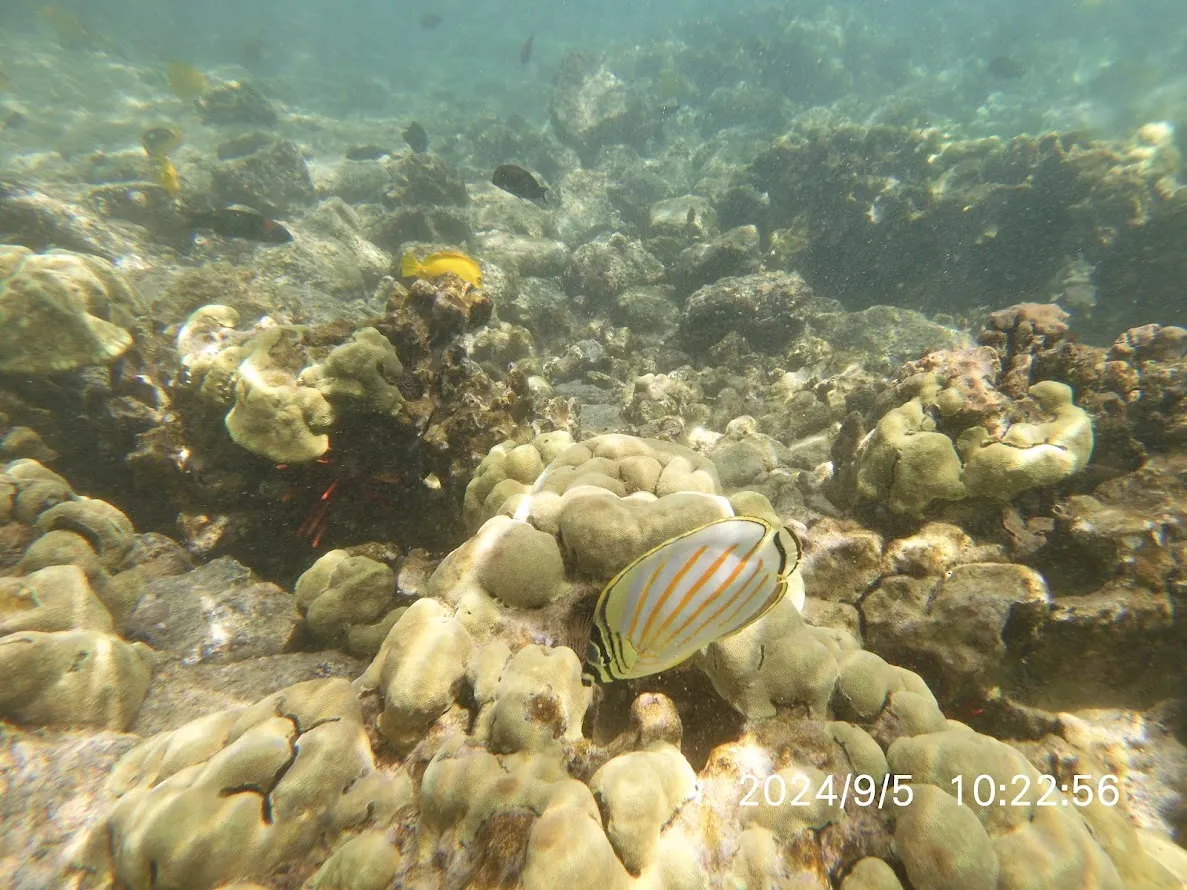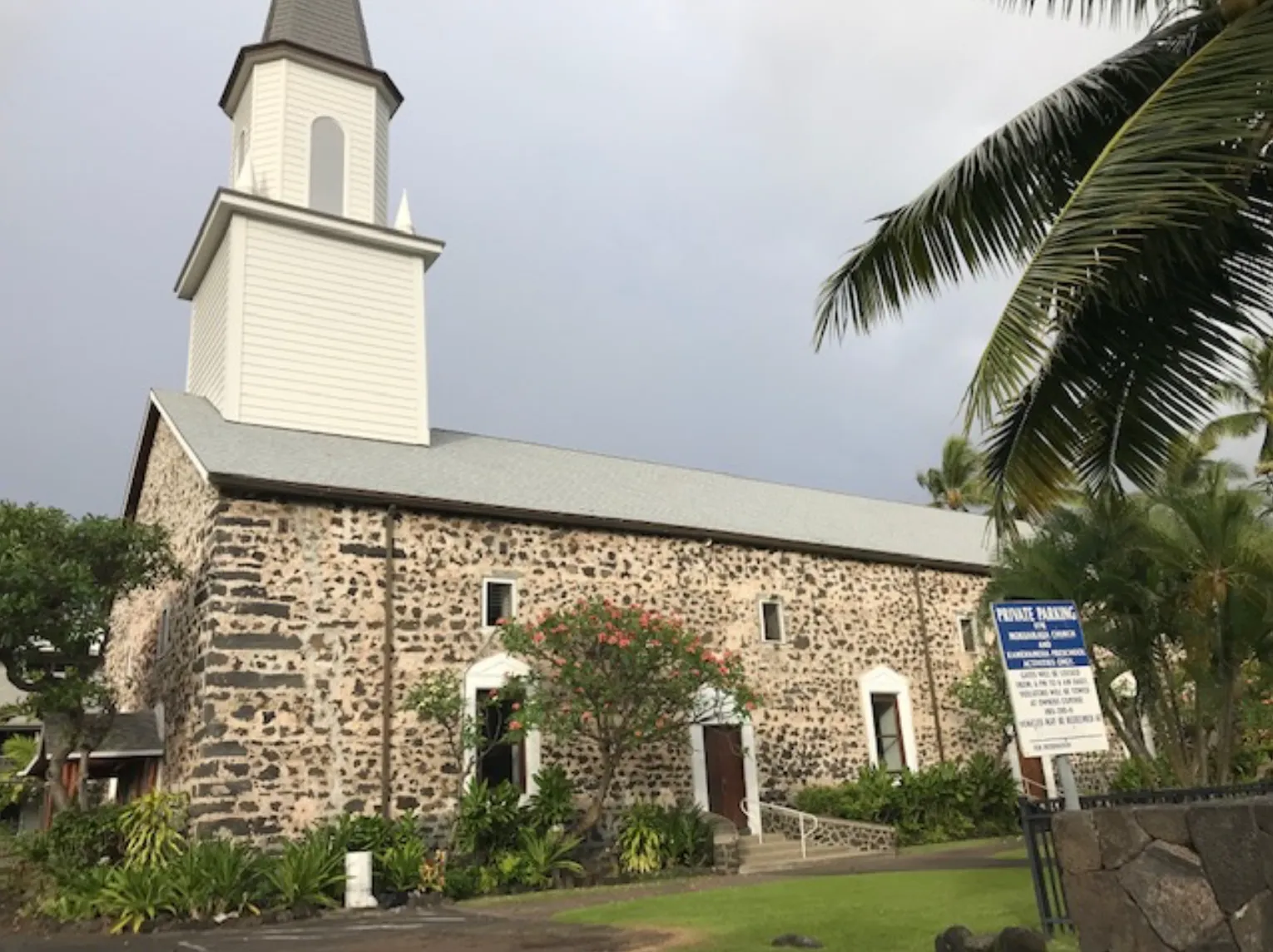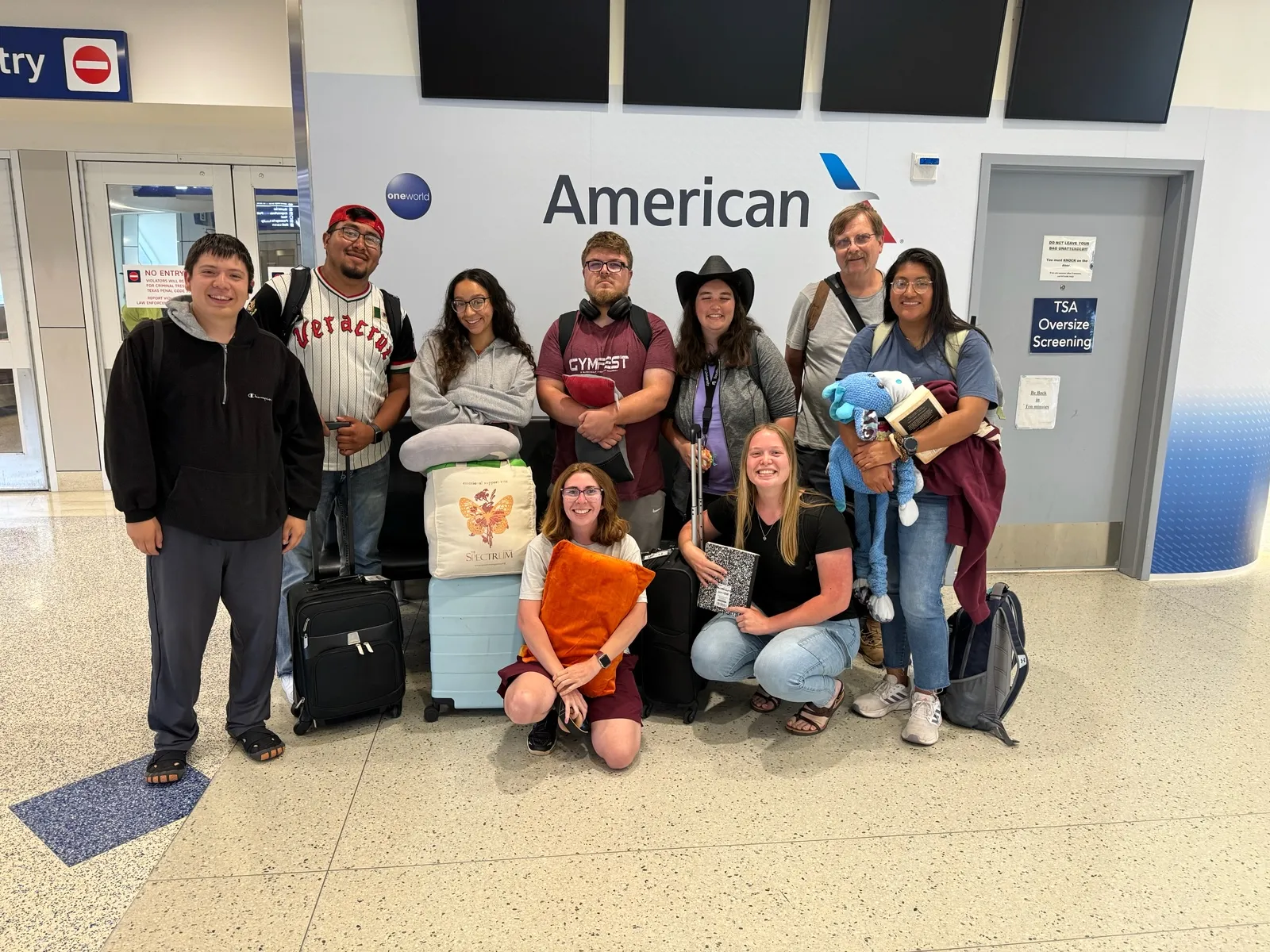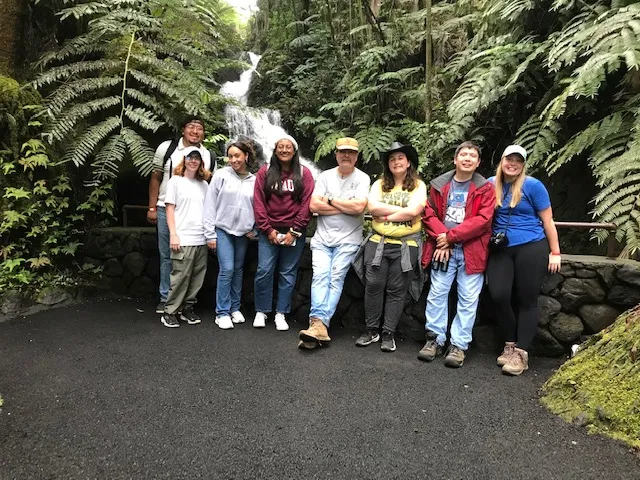Biology Students Study in Hawaii
Jun 17 2024 - 9:53am
By: Dr. Arthur Schwarz
Recently, biology students journeyed on a field research trip to explore islands of Hawaii. This class involved studying the environment, flora, fauna, culture and history of the Hawaiian Islands. Dr. Arthur Schwarz, professor of biological studies, led the class. Following, Schwarz shares a brief travel journal, with quotes from students.
Arrival on the Big Island
Wednesday, May 8, 2024
We had a 29 hour day. Getting up at 3 am and flying five time zones west will do that! After traveling for what seemed like all day, we arrived in Kona just after lunch time. For us it seemed like dinner time, but we found a Thai restaurant and enjoyed lunch time prices. Since we could not move into our Airbnb until 4 p.m., we went grocery shopping. Groceries are EXPENSIVE here! Nearly everything is shipped to Hawaii.
“There were a lot of interesting things to see around the restaurant – today we had our first view of the flora and fauna of Hawaii.” Emma Carlson, Sophomore, Biology Ecology & Conservation
Observing Nature at Land and Sea
Thursday, May 9, 2024

Bright and early, due to jet lag, we began our 1.5 mile hike (according to the map) down to the Captain Cook monument on the Kona coast of the Island of Hawaii. The monument marks the spot where Captain James Cook, discoverer of the Hawaiian Islands, met his end in 1779. It also happens to be one of the best sites for snorkeling and observing tropical reef fish. The hike down was one thing, but coming back up was a chore! Everyone was sure that it was much longer than 1.5 miles!
“This was a challenging, but rewarding day. The fish were amazing and beautiful!” Jaleigh Garmon, Senior, Online Media
“The clear, blue water was absolutely amazing!” Aubrey Peterson, Senior, Integrative Biology
“I liked listening to the sound of the ocean.” Emily Hayes, Integrative Biology
“That hike was longer than 1.5 miles! But that view in the water was worth it! I got browner in the sun and lost weight too.” Katherine Gomez, Senior, Integrative Biology
“The water and seeing the endemic fish was totally worth it!” Emma Carlson, Sophomore, Biology Ecology & Conservation
“We got to see so many endemic Hawaiian species.” Alessandro Franchini, Senior, Integrative Biology, English Writing
Rare Birds at Volcanoes National Park
Friday, May 10, 2024
No one visiting Hawai'I, the biggest island of the chain, should miss out on spending time at Volcanoes National Park. We did not miss out! The island chain is born of fire and molten rock. During the last major eruption, which continued for about 10 years, nearly 900 acres of new land were added to Hawaii in 2018 alone, the last year of the extended eruption. Volcanic eruptions are seen as both good and bad. Good for the fact that they build new land, but bad for their destruction.
We hiked through the rainforest (yes, it was raining), explored the Thurston Lava Tube, where a river of molten rock flowed hundreds of years ago, and looked at the many craters along the Chain of Craters Road. We marveled at the evidence of the violence of the eruptions, and the fact that new craters can be formed basically overnight, as in the case of Kilauea Iki.
On the other hand, the rainforest is the home for Apapane, a rare species of bird, found only in the Hawaiian Islands, as well as other species that delighted us to observe. Next to the ocean we observed the Hawaiian Black Noddy, a bird that only nests in cavities in cliffs just above the ocean spray zone.
“A shocking, unexpected, eye opener about the power of volcanos. From this experience we can understand how volcanism deserves respect.” Desi Gomez, Junior, Theology
“Park Ranger Gallager gave us a fascinating presentation about the suddenness and violence of eruptions.” Seth Carrizosa, Senior, History Secondary Teaching
“The craters are ginormous! The lava tube was like a cave. You wouldn’t believe that it was formed by molten lava.” Aubrey Peterson, Senior, Integrative Biology
“I see a spiritual comparison. Fire and brimstone (lava) is associated with judgment and destruction, but here on the edge of the island it is also associated with creation.” Alessandro Franchini, Senior, Integrative Biology, English Writing
Resting on the Beach
Sabbath, May 11, 2024

We attended the nearby Kona Seventh-day Adventist Church. Everyone liked the practical sermon we heard about prayer from a newly hired pastor. We had been looking forward to the weekly potluck that most churches have in Hawaii. Unfortunately, the Kona church now has potluck every other week, so we took our cheese enchiladas, chocolate cake, and fresh tamarindo drink home and consumed it by ourselves.
On our way down to the Captain Cook monument on Thursday, we passed a Tamarindo tree with mature fruit. Desi had climbed the tree to get the fruit. On Friday evening, Katherine showed us how to make tamarindo drink. It was good! Later that Sabbath afternoon, we found a beach, which was actually hard because the beaches in the north were closed due to damage by a recent storm. Because of lava flows, Hawaii island does not have many beaches. It takes hundreds of years for a beach to form. Eventually we did find a beach that was not damaged. The surf was a little high and we tried our hand at body surfing.
“The church we went to was gorgeous with a great view. I had a great experience there, feeling connected to Christ both at the worship service and in the afternoon while enjoying the Creation.” Seth Carrizosa, Senior, History Secondary Teaching
“I almost broke my back in the surf. I found out what it is like in a washing machine.” Katherine Gomez, Senior, Integrative Biology
“The surf curl ripped off my water shoes. I only found one of them.” Dr. Arthur Schwarz, professor of biological studies
“The sunset was absolutely beautiful!” Emma Carlson, Sophomore, Biology Ecology & Conservation
“God painted us a picture in the sunset.” Emily Hayes, Integrative Biology
Students Present Research in the Field
Sunday, May 12, 2024
Everyone had little projects during the trip, and we had to travel to different places on the island to accommodate the projects.
Jaleigh is interested in how the volcanic eruptions have disrupted people’s lives and communities. We visited Lelani Estates, where numerous people had their homes and properties destroyed by lava in 2018. She interviewed one of the long-time residents who was there during the last major eruption. We toured the neighborhood to see the destruction for ourselves and learned how the community is moving forward. Some people experienced survivor’s guilt, where they felt bad because their homes were not destroyed, while their neighbor’s were.
Emily is interested in the Indian mongoose (Manakuke in Hawaiian), which is considered a pest species because it depredates ground nesting birds, such as Hawaii’s State Bird, the Nene goose, found nowhere else in the world. It is thought that Nene arrived in the islands when a flock of migrating Canada geese were blown off course in a storm and landed in Hawaii. The mongoose was introduced to control rats in sugarcane fields but that was unsuccessful because mongoose are diurnal and rats are nocturnal. Mongoose can be observed hunting cooperatively together, and are everywhere on Hawaii at lower elevations.
Katherine is interested in the most common native tree on Hawaii, the Ohia lehua. In her presentation, given in the rain, she described the folklore surrounding its name, as well as its biology. It is among the first to colonize new lava flows and provides an environment that other species can colonize. Thus, it is vital for reestablishing the forest after 200 years or so.
Desi is interested in the story of Christianity in the islands. The early Hawaiians were pagan and very superstitious. They had a pantheon of gods at the time of discovery in 1778, even thinking that Captain Cook was Lono, the god of agriculture. But within two generations, Christianity was widespread and accepted. How did this happen? We visited a little church in the isolated fishing village of Miloli’i. It is still being used since it was built in 1865. The site is revered by the locals because it has survived natural disasters with little structural damage, such as when a tsunami moved the building 300 yards off its foundation in 1868. Other buildings were completely destroyed, but no lives were lost. The site where the church once stood is now underwater. This event helped the people of Miloli’I understand and respect the power of the true God.
In between these places, we visited other sites, such as the Ka’u desert, which is remembered for its history in Hawaii. We visited South Point, the southernmost part of the United States. We watched people jump off the 40 foot cliff and we talked to the fishermen there. We visited a Farmer’s, Arts, and Crafts Market. It was interesting to see the rich blend of Polynesian, Asian, Hispanic, and American cultures that characterizes Hawaii, our 50th state.
Rare Sightings on Mauna Kea
Tuesday, May 14, 2024
Today, we went as high as we possibly could on Mauna Kea, the highest mountain on the Island of Hawaii. It was chilly and a little wet up at the Onizuka Center for International Astronomy Visitor Information Station, located at 9,200 feet in elevation. This is as high as you can go without a 4-wheel drive vehicle, but higher up are 10 world class astronomical telescopes of various types and sizes. We were able to see the very rare silver sword, a plant only found on two of the highest peaks in Hawaii.
From there, we drove down to see “islands” of mature forests, where lava from Mauna Loa destroyed some portions of forests, but not others. These islands, called “kipuka” in Hawaiian, are an oasis for wildlife, and seed sources eventually enabling recolonization of the lava. The keenest birders among us were able to observe three different species of honeycreepers, a rare group of finch-like birds found only in Hawaii.
Driving down to sea level, we were able to observe the change in vegetation zonation, something we learned about in class. Once at the rocky shore, we visited Hawaii Tropical Botanical Garden, located in a high rainfall area. This garden was absolutely beautiful, with over 2,700 plant species. The garden specializes in orchids, heliconias, palms, gingers, and arums, some of which can no longer be found in their native habitat. That wrapped up our day, except for pizza for dinner.
“The green vegetation starkly contrasted with the black destruction caused by the lava flows. The garden was like a slice of paradise.” Katherine Gomez, Senior, Integrative Biology
“Seeing the rare I’iwe (one of the honeycreepers) in person, with it’s curved beak, and red and black feathers, was absolutely stunning.” Aubrey Peterson, Senior, Integrative Biology
“I liked the endlessly different variations of orchids at the garden. Seeing the honeycreepers was the highlight of this island.” Emily Hayes, Integrative Biology
“We saw the endemic Hawaiian crayfish!” Alessandro Franchini, Senior, Integrative Biology, English Writing
“I enjoyed the change in weather going up the mountain, even the rain.” Desi Gomez, Junior, Theology
The Hawaiian Owl and Other Wildlife
Wednesday, May 15, 2024
Today we got to see Green Sea Turtles, six of them in fact, in the shallows of tide pools. They come to sun themselves in the shallow water while they rest and eat green algae that grows on the submerged lava rock. All sea turtles are strongly protected by law, so that an observer cannot approach within less than 20 feet. This and other protective measures have helped, because sea turtles have become more common in recent decades.
Up at higher elevations, we looked in grassy, sparse tree habitat for the Pueo, or Hawaiian owl. Emma gave her presentation on this diurnal owl that is found only in Hawaii. At first we could not find Pueo, but after Emma gave her presentation, we found first one and then a second one along a road we were traveling. Emma was so excited to see them! Her excitement infected the rest of us.
Next, we visited Pu’ukohola Heiau, a stone platform commemorating where Kamehameha I finally unified the Island of Hawaii under one leader in 1791. It is a sacred place of great significance for Hawaiians. Unification of the other islands would come later. Some of us, more enthusiastic about birding, went back to earlier sites to see if we could add more birds. All things told, it was another wonderful day!
“Pueo. Ahhhhhhh!!!! It was my favorite day of the trip so far!” Emily Hayes, Integrative Biology
To Kauai Island and Makanalani Camp
Thursday, May 16, 2024
Today we moved from Hawai’i, the big island, at the southeast end of the Hawaiian island chain, to Kauai at the northwest end of the Hawaiian island chain. Getting all packed up, cleaning up at the Airbnb, and getting to the airport to catch our flight took all morning. We arrived on Kauai before noon. We discovered that the large van we rented on Turo was large enough to take all of us, but not large enough to move all of us and our luggage. [sigh]. By the time we rented another minivan, everyone was hungry. After fast food, we set out to find Makanalani Camp, where we will stay for the next four days.
The owners of Makanalani, which means “gift from heaven”, had a dream to have a place where children can come to experience the wonders of God’s creation. It’s 170 acres of absolutely beautiful island vegetation and tropical fruit trees. There is a profusion of birds and a few domestic animals on this working farm.
The central building where we stay reminds me of an upscale resort in its décor and design. The kitchen in the central pod was a dream for our cooks. What is the most amazing thing about it? It is operated by volunteers and runs on donations! Yes, we left a donation!
Birdwatching and a Slower Way of Life
Friday, May 17, 2024
Today, our only agenda was to explore the north shore of the island. There is nothing fast-paced on Kauai. Pretty much the whole island is considered rural. The “highway” in the north part of the island is a narrow, winding road with one lane bridges, and usually has a speed limit of 25 mph. There are roadside fruit stands, foot traffic and cars parked along the narrow road, but no one is in a hurry.
The beauty of the beaches, waves, steep rocky hills, and green tropical vegetation is stunning. It rained most of the day – but that is why everything is green. Oh yes – the bird watchers among us were finally able to see the Nene goose, Hawaii’s state bird, the Hawaiian duck, and some other birds not previously seen on our trip. We made our way back to Makanalani early to prepare dinner, prepare for Sabbath, and prepare enchiladas for potluck tomorrow.
“There is such a vast difference between Kauai and Hawai’i! It’s shocking! The Nene goose is doing well here because there are no mongoose to predate its nests.” Emily Hayes, Integrative Biology
Fellowship With Locals
Sabbath, May 18, 2024
On Sabbath morning, we attended the Kapa’a church. An intern from Montemorelos had the sermon, which included her testimony. Most Hawaiian churches have potlucks every Sabbath due to so many visitors. About 1/3 of the people there were visitors. After the potluck, it was raining profusely, so instead of going to a beach as planned, we joined several church members in participating in a singing band at an elder care facility. Later, we went to one of the church member’s homes for fresh coconut, pineapple, papaya, and grapefruit, all grown on the property. After sundown we watched movies or sports events until bedtime.
The Grand Canyon of the Pacific
Sunday, May 19, 2024
On Sunday we had a few people coming down sick, so only six of us went up the mountain to Kokee, near the top of Mt. Waialeale. In Hawaiian, this name literally means “wet, very very”. And it is wet up there, as it rains nearly every day. In fact, the Hawaiians had it right. It is the wettest place on earth, with a record annual rainfall of over 600 inches of rain in one year. Though it is a mountain top, the water does not drain off fast enough. The mountain is highly eroded with beautiful fluted valleys, The main drainage off the mountain is the Waimea canyon, also known as the grand canyon of the Pacific. It’s a few thousand feet deep. We were lucky to be there when it was not raining and with few clouds – very unusual! In the forest, some of us observed the Kauai Elepaio, a delightful little bird that is not shy about approaching humans out of curiosity.
“I was overjoyed about seeing Elepaio up close!” Alessandro Franchini, Senior, Integrative Biology, English Writing
Last Day on the Island
Monday, May 20, 2024
Today we had a chill day. We had to move out of our tropical Makanalani, Gift from Heaven paradise, and take up residence in a very ordinary tourist hotel by a rocky beach in Kapaa. Everyone did a little shopping, chilled at the pool, or walked along the beach.
A Successful Trip
Monday, May 20, 2024

Today we head back to Dallas, or home, wherever that may be. We had more time to chill and relax. The coursework is finally over! All in all, it was a very successful trip. I'll do it again next year with a different group of students!
